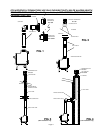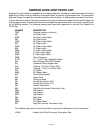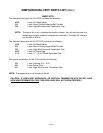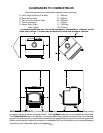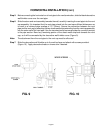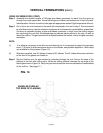
Page 18
FIG. 5
FEMALE LOCKING LUGS
MALE LOCKING LUGS
HORIZONTAL INSTALLATION
NOTE: RESTRICTOR STRAP IS REQUIRED IF HORIZONTAL VENTING CONFIGURATION HAS 10’
OR GREATER OF VERTICAL RISE AND NOT MORE THAN ONE 90 DEGREE ELBOW.
Step 1. Set the gas stove in its desired location. Check to determine if wall studs or roof rafters are in the
way when the venting system is attached. If this is the case, you may want to adjust the location
of the stove.
Step 2. Simpson Dura-Vent pipe is designed with special twist-lock connections. To connect the venting
system to the stove flue outlet, a twist-lock adapter is built into the stove at the factory. Assemble
the desired combination of pipe and elbows to the adapter with pipe seams oriented towards the
wall or floor, as much out of view as possible. Remember to include wall thickness in minimum
clearances when figuring the measurements for your installation needs.
Note: Prior to joining pipes apply a high temperature silicone sealant with a rating of 500 degrees
Fahrenheit or greater to outside joint of vent pipe.
Twist-lock procedure: Four indentations, located on the female ends of pipes and fittings, are
designed to slide straight onto the male ends of adjacent pipes and fittings by orienting the four
pipe indentations so they match and slide into the four entry slots on the male ends (Figure 5).
Push the pipe sections completely together, then twist-lock one section clockwise approximately
one-quarter turn, until the two sections are fully locked. The female locking lugs will not be visible
from the outside, on the pipe or fittings. They may be located by examining the inside of the
female ends. There is a 1/4” rise per foot minimum on horizontal run.
NOTE: Horizontal runs of vent must be supported every 3’ (914mm). Wall straps are available for this
purpose. (See Parts List, pg. 12)




